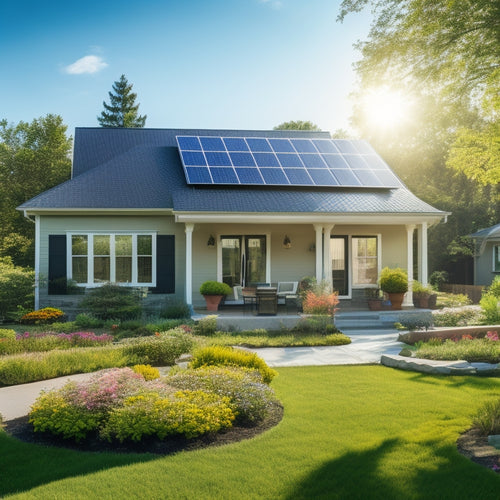
Solar Energy Solutions - The Future of Renewable Energy
Share
You're embracing a future where solar energy is the primary source of power, and it's not hard to see why: as the most abundant renewable energy source, solar energy has the potential to greatly reduce our reliance on fossil fuels and lower energy costs, making it an attractive solution for a sustainable tomorrow. By integrating solar technology, you can considerably reduce your carbon footprint, improve local air quality, and enjoy cost-effective solutions. With advancements in solar panels, energy storage, and grid parity, the shift to solar energy is becoming increasingly viable. As you investigate the world of solar energy solutions, you'll uncover even more ways to utilize the power of the sun for a brighter future.
Key Takeaways
- Solar energy solutions reduce carbon footprint, promoting a healthier planet and energy independence from the grid.
- Advancements in technology have made solar energy more affordable, with costs declining over the years.
- Grid parity has been achieved in many regions, making solar energy a viable option for consumers.
- Energy storage systems and backup power systems ensure a steady energy supply despite variability in solar generation.
- Global adoption of solar energy solutions is driven by installation incentives, international collaborations, and public awareness campaigns.
Harnessing Power From the Sun
As the most abundant renewable energy source, the sun's energy is waiting to be tapped, and utilizing its power is becoming increasingly important in today's quest for sustainable living.
You're likely aware that solar energy potential is vast, with the sun emitting approximately 1366 watts of power per square meter of the Earth's surface. To capture this energy, you'll need to integrate solar technology into your infrastructure. This involves installing photovoltaic (PV) panels or solar thermal systems that convert sunlight into electricity or heat.
By doing so, you can reduce your reliance on fossil fuels and lower your carbon footprint. Effective solar technology integration requires careful planning, considering factors such as panel orientation, shading, and energy storage.
When done correctly, solar energy can provide a significant portion of your power needs, decreasing your energy costs and increasing your independence from the grid.
Environmental Benefits of Solar Energy
You're likely aware that traditional energy sources have considerable environmental drawbacks.
By switching to solar energy, you'll considerably reduce your carbon footprint and preserve natural resources for future generations.
Additionally, solar energy generates clean air, mitigating the negative impacts of air pollution on our ecosystem.
Reduces Carbon Footprint
Your shift to solar energy solutions greatly reduces your carbon footprint, an essential step towards mitigating climate change. By utilizing the power of the sun, you're decreasing your reliance on fossil fuels, which are significant contributors to greenhouse gas emissions.
This reduction in carbon emissions not only helps combat climate change but also improves local air quality, reducing the negative impacts on public health.
Government-backed solar incentives and energy policies have made it more accessible and cost-effective for individuals and businesses to convert to solar energy. These initiatives provide financial benefits, such as tax credits and rebates, to encourage the adoption of renewable energy sources.
As a result, you can enjoy significant savings on your energy bills while doing your part to protect the environment. By choosing solar energy solutions, you're not only reducing your carbon footprint but also supporting a sustainable future for generations to come.
Preserves Natural Resources
In utilizing the power of solar energy, you're tapping into an infinite resource that's abundantly available everywhere. This means you're not depleting finite resources, like fossil fuels, which are extracted from the earth. By utilizing solar energy, you're reducing your reliance on these limited resources, contributing to their conservation. This approach aligns with sustainable practices, ensuring a healthier planet for future generations.
Solar energy's renewable nature eliminates the need for resource extraction, processing, and transportation, which can harm ecosystems and cause environmental degradation. By choosing solar power, you're minimizing the demand for resource-intensive energy production methods. This, in turn, helps preserve natural resources, reducing the strain on the environment and promoting a more circular economy.
As you adopt solar energy solutions, you're actively participating in resource conservation, reducing the pressure on the planet's natural reserves. This responsible approach to energy generation not only benefits the environment but also supports a more sustainable future for all.
Clean Air Generation
One of the most significant environmental benefits of solar energy is its ability to generate clean air. You can utilize the power of solar energy to improve indoor air quality through solar air purification systems. These systems use solar panels to power air filters, removing pollutants and toxins from the air.
Here are three ways solar energy can generate clean air:
-
Solar air purification: By integrating solar panels with air filtration systems, you can purify the air without relying on fossil fuels. This technology is particularly useful in urban areas where air pollution is a significant concern.
-
Solar indoor farming: Indoor farming uses solar energy to power LED grow lights, creating a controlled environment for plant growth. This method not only produces fresh produce but also purifies the air through photosynthesis.
-
Reduced emissions: By switching to solar energy, you reduce your reliance on fossil fuels, which in turn reduces greenhouse gas emissions and air pollutants.
Cost-Effective Solar Solutions Today
Cost-Effective Solar Solutions Today
By leveraging advancements in technology and manufacturing, the cost of solar energy solutions has plummeted, making them a viable option for individuals and businesses alike. You can now take advantage of affordable installations that cater to your energy needs without breaking the bank.
One way to achieve this is through community solar programs, which enable multiple individuals or organizations to share the benefits of a single solar array. This approach reduces the upfront costs and increases accessibility to clean energy.
Community solar initiatives are gaining traction, offering you a chance to participate in the renewable energy movement without having to install solar panels on your property. By investing in a shared solar system, you can offset your energy consumption with clean electricity, reducing your reliance on the grid and saving on your utility bills.
With the cost of solar energy solutions continuing to decline, you can now enjoy the benefits of renewable energy without the hefty price tag. Investigate your options today and uncover how cost-effective solar solutions can enhance your energy independence.
Advancements in Solar Panel Technology
As you investigate cost-effective solar solutions, you're likely to find that advancements in solar panel technology play a significant role in driving down costs. These advancements have led to increased energy efficiency, allowing you to generate more power with fewer panels.
Some of the most notable advancements include:
-
Bifacial panels, which can capture energy from both sides of the panel, increasing energy output by up to 25%.
-
Perovskite cells, a new type of solar cell that's cheaper and more efficient than traditional silicon-based cells.
-
Solar tracking systems, which adjust the panel's angle to maximize energy output throughout the day.
These advancements have also led to the development of innovative technologies like transparent solar panels, integrated photovoltaics, and smart inverters.
Additionally, dual use applications, such as building integrated solar panels and off grid systems, are becoming increasingly popular.
These advancements haven't only made solar energy more accessible but also more efficient, creating a foundation for a more sustainable future.
Grid Parity and Energy Independence
The goal of solar energy solutions is to achieve grid parity, a point where the cost of generating solar energy is equal to or less than the cost of purchasing traditional grid power. As you consider shifting to solar energy, you'll want to understand the benefits of grid parity and how it can lead to energy independence.
Grid parity is already a reality in many parts of the world, where the cost of solar energy has fallen dramatically in recent years. This is largely due to advancements in solar panel technology and favorable energy policies. With net metering, you can generate your own electricity and export any excess back to the grid, reducing your reliance on traditional power sources.
Here's a snapshot of the current state of grid parity around the world:
| Region | Cost of Solar Energy (¢/kWh) | Cost of Traditional Grid Power (¢/kWh) |
|---|---|---|
| USA | 10-15 | 12-15 |
| Europe | 8-12 | 15-20 |
| Australia | 6-10 | 15-25 |
| India | 5-8 | 8-12 |
| China | 4-6 | 6-10 |
As you can see, solar energy is already competitive with traditional grid power in many regions. With continued advancements in technology and favorable energy policies, the goal of achieving grid parity and energy independence is within reach.
Solar Energy Storage and Backup
You've achieved grid parity, now you're generating your own clean energy and enjoying the benefits of energy independence.
However, you're aware that the sun doesn't always shine, and energy storage is essential to guarantee a steady supply of power. This is where solar energy storage and backup come into play.
To address energy efficiency and reliability, you'll need to take into account the following:
- Battery Technologies: Advancements in battery technologies have made it possible to store excess energy generated during the day for use during the night or on cloudy days.
Lithium-ion batteries, lead-acid batteries, and flow batteries are popular options.
- Energy Storage Systems: These systems manage the flow of energy between your solar panels, batteries, and the grid.
They optimize energy efficiency, monitor performance, and provide backup power during outages.
- Backup Power Systems: These systems guarantee a continuous supply of power during grid outages or when your solar panels aren't generating enough energy.
They can include diesel generators, gas generators, or other alternative power sources.
Global Adoption and Future Prospects
With solar energy solutions gaining traction worldwide, it's exciting to investigate their global adoption and future prospects. As you examine the global terrain, you'll notice that solar policy and market trends are driving growth. Governments are offering installation incentives, and international collaborations are encouraging technological innovations.
Public awareness campaigns are also playing an important role in increasing adoption rates. Financing options are becoming more accessible, making solar energy a viable choice for individuals and businesses.
However, regulatory challenges still exist, and addressing these will be essential for a seamless energy changeover. Workforce development is another significant aspect, as the industry requires skilled professionals to install and maintain solar infrastructure.
Despite these challenges, the future looks bright for solar energy. As the world continues to shift towards renewable energy, you can expect to see substantial growth in the industry. With continued innovation and investment, solar energy is set to become a dominant player in the global energy framework.
Frequently Asked Questions
Can Solar Energy Be Used for Heating Water and Homes?
You can utilize solar energy to heat water and homes using solar water heating systems, which convert sunlight into thermal energy, providing a reliable and efficient way to warm your space and water supply.
Are Solar Panels Fragile and Prone to Damage?
You might think solar panels are fragile, but they're built to last, with durable materials ensuring high impact resistance, and rigorous testing guaranteeing their solar panel durability, so you can rely on them to capture the sun's power efficiently.
Can I Install Solar Panels on My Apartment Balcony?
You can install solar panels on your apartment balcony, but you'll need to evaluate balcony installation constraints and space limitations; assess your balcony's structural integrity, available space, and local building codes before determining feasibility.
Do Solar Panels Work Well in Cloudy or Shady Areas?
Like a shadow cast on your renewable dreams, cloudy skies can hinder solar panel efficiency, but don't be discouraged - modern panels still perform relatively well in cloudy weather, capturing around 25% of potential energy, so you can still utilize some power on overcast days.
Can I Use Solar Energy to Charge My Electric Vehicle?
You can charge your electric vehicle using solar energy, leveraging solar charging stations or installing a solar-powered EV charger at home, which can optimize EV efficiency, reducing your carbon footprint and energy costs.
Conclusion
As you look to the future of renewable energy, remember that solar energy solutions are leading the charge. With the ability to power 27 million homes, the 72 gigawatts of solar energy installed in the US alone is equivalent to taking 43 million cars off the road. As technology continues to advance and costs decrease, it's clear that solar energy will play a crucial part in shaping our planet's sustainable future.
Related Posts
-

Integrating Smart Technology for Energy Savings
Integrating smart technology into your home is a transformative factor for energy savings. Smart thermostats give you...
-

Sustainable Home Design for Reduced Carbon Footprint
Sustainable home design is your pathway to a smaller carbon footprint and a healthier living space. By incorporating ...
-

Affordable Solar Panels for Home Use
Affordable solar panels offer you a smart way to cut down on energy costs while promoting sustainability. With govern...


